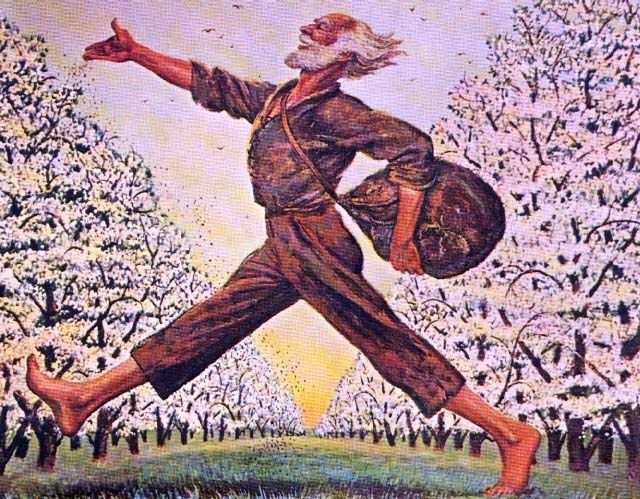History of the Nerd part 1: Johnny Appleseed
This is how I know about Johnny Appleseed: a Disney Cartoon where there are friendly woodland creatures and a catchy theme song. This short was bundled in a shorts package consisting of other American icons to make up the Disney feature American Legends. They had Johnny, of course, Paul Bunyan, John Henry and The Brave Engineer. I have always thought that these were just tall tales that were passed down through oral tradition and have never known that they had some basis in reality. Johnny Appleseed was a real flesh and blood person and his story of selflessness and generosity were more heroic than any legend. John Henry was a steel driv’n man but was there really a man who worked the rails? What about Paul Bunyan? Was there really a giant guy with a very, very close relationship with his giant blue ox? Well, for Paul the answer is no. He’s total bullshit… or oxshit.

Johnny Appleseed’s true name was John Chapman and he was born in Leominster, Massachusetts: the “you could keep your fucking tea” state (thank you, John Hodgeman, for that joke I just stole). He was born to Nathaniel and Elizabeth Chapman on September 26, 1774. They held the child out towards the setting sun against the fiery golden sky. All of the animals of the plains gathered forth and bowed their heads down low (cue Lion King music). The Chapman family was, like many families of the time, ragged and poor. Some say that Nathaniel lost two farms during the Revolutionary War, but in truth there is no historical fact that supports Nathaniel being a farmer at all. He held no deed record to suggest this. But this matters little because he was still the father that sent Johnny on his way to becoming the great man that he was by pawning him off onto yet another man. Johnny was made to apprentice under a Mr. Crawford, who was a man who owned an apple orchard. “Apprentice” was what white people were called when they did slave work back then. During this time, Elizabeth, Johnny’s mother, died giving birth to a child that did not survive. Johnny’s father would later remarry.
Wanderlust grew within the beating heart of his honey breast. The wild called to him and in 1792 at the age of 18 John Chapman could bear it no longer. He took to the west, taking his 11 year-old half-brother (who was also named Nathaniel) with him. The plan was to make it to the headwaters of Susquehanna. The accounts of his travels are a bit hazy. Being the son of an under educated out of work farm hand, he surprisingly wasn’t taught to keep records in journals or apparently to wash and wear nice clothes. He was like a wild monkey set out onto the land, but at least he knew how to read, which is already doing much better than sixty percent of our public school children are now.
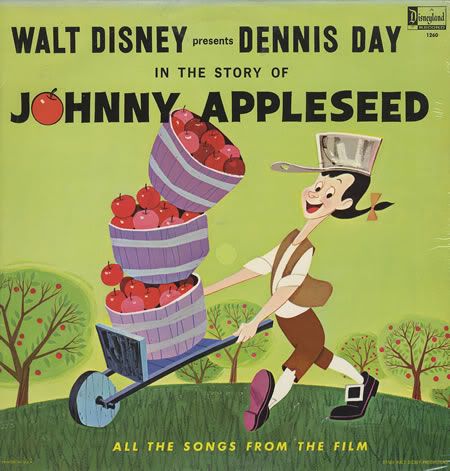
You may think of Johnny Appleseed as a seed scattering inbred country yokel but that would be judgmental and far from the truth. You should be ashamed of yourself. Apples don’t “true grow” from seeds. An apple tree grown from a seed actually bears little resemblance to its parent. The fruit from these bastard trees would be almost inedible ranging from sour to bitter. In order to get consistent tasting fruit from apples you must clone the tree. The farmer or orchardist would graft trees from preexisting trees that have properties they liked then make an exact duplicate over and over again. Finally, what do you know, you have “Washington Red Apples”. In truth, apples in America prospered because of a process of directed natural selection.
Apples are not indigenous to the Americas. They were brought over to the New World by the earliest settlers, the Pilgrims, sometime around 1620. That makes the saying “as American as apple pie” pretty retarded, especially since the recipe for apple pie is really Dutch. So the next time your mom says that, be sure to slap her in the mouth and call her a dumb bitch, but only do so if you are white trash. Trees grown from seedlings known as “pippins” prospered in New England. Why were they called “pippins”? Because the British has to gay up anything they name. The trees grew even better after the colonists imported honeybees to improve pollination.
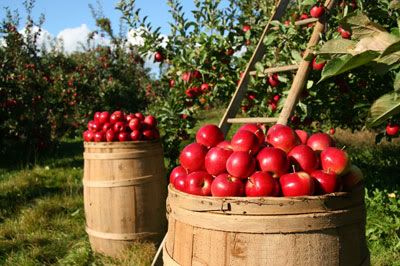
Now, we all know that apples are nutritious, but back during Chapman’s time apples were not mainly eaten. Instead they were use to make booze; Hard Cider to be exact. Johnny wasn’t just an apple peddler, but the Mother Teresa of that happy fun time juice known as alcohol. You may know Hard Cider by its street name: Apple Jizz. Settlers pressed the apples to produce juice and then allowed the juice to ferment in a barrel for a week or two. The final product was a mild alcoholic beverage that was half the strength of wine. If you want a faster ticket to wino city you could distill the cider to brandy (yum) or freeze it into applejack, which is 66 percent proof (bad ass). In many rural areas, cider supplanted wine, beer, coffee, juice and water for the whole family. These were primitive times where entertainment choices were minimal, so why not spend the entire day in a drunken stupor? The party went on until the 1900s and then we had to start eating apples instead of downing them. The bitches known as the Women’s Christian Temperance Union publicized the evils of alcohol, and pulled the plug on the nation’s collective mixed tape and ended the party for everyone. Prohibition was coming and there wasn’t shit that anyone could do about it. The apple industry felt the direction that the wind was blowing and decided to rebrand the apple. “An apple a day keeps the doctor away” was an old adage from the 1800s that was undated and turned into an advertising slogan. The apple would have its comeback during the great depression when fruit sellers stubbornly refused to sell anything else.

But we’re getting away from the subject of this tale. Last we left off, our intrepid Monkey-man had taken off west with his younger brother in tow. I’m sure that after a week into the trip Johnny must have wanted to beat the child over the head and use his flesh for sustenance, but Johnny was a strict vegetarian. In the spring of 1798 he was travelling along the Allegheny River when he found the spot that would be the location of his first apple nursery. We know through land records dated in 1800 that John Chapman was standing in what today is Licking County, Ohio.
In Licking County, John was in a planting fever. Congress decided to give the Revolutionary War Vets a bone by passing legislation that would allow them to have from 160 to 2,240 acres of land in the area which up until then belonged to the Indians (because everything used to belong to the Indians). It was nice for the Indians to give the land freely and without a fuss to the Union knowing that Manifest Destiny was ultimately on the White-Man’s side. I mean how can you argue with God, right? Of course, the government took its sweet time doling out deeds so soldiers actually did not receive letters of patent to their grants until 1802. By the time the veterans arrived, Johnny’s nurseries, located on the Isaac Stadden farm, had trees big enough to transplant. Johnny had done most of the work already for them. He would sell each apple tree at five or six cents apiece.
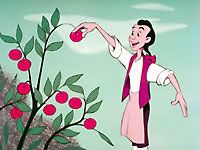
In 1805, the elder Nathaniel Chapman, John’s father, arrived with his second family and John’s brother Nathaniel Jr. rejoined his father. Nathaniel Jr. would spend the rest of his life trying to keep the memories of rough living and the constant taste of apples out of his mind. This freed Johnny to fill his heart with the wild life of nature that he held so dear. He would go on to spend the rest of his life planting and, because he was a religious man, preaching.
Johnny was fairly shrewd when it came to business. He tried to predict where the pioneers were likely to settle. In those early days, the sites were mainly along the Muskingum River in north central Ohio. He would load a canoe with a mass of seeds and paddle up the river looking for a nice piece of land. He would plant and then wait for nature to take its course. Settlers would come and he would sell to them. The routine John had worked out for himself was to return to his orchards in Allegheny County to get more seeds in the autumn. In the spring he would then look for more sites to plant nurseries and fence them in. In the summer he would go and tend to the fences and nurseries he already had and hire a local agent to take care of the trees. He would then move on and start the whole process over again. This caused him to be on constant movement, traveling with the frontier as he tamed it in his wake. The consequence was that he never had a fixed residence for his entire life. What we call a bum today was what they called a “frontier man” back then.
John Chapman was the apple expert, but he also brought with him many seeds of medicinal plants and the knowledge of how to use them. Ever generous to help his fellow man, he was always ready with aid or to even help with chores. The people began to take notice of him and he became a welcome face. His deeds did not go unnoticed. His legend began to grow, and by 1806 people nicknamed him Johnny Appleseed. Settlers had accounts of welcoming him in to their homes. They would feed him hot meals and provide a solid roof over his head to sleep under. He would exchange their kindness with apples or apple trees and even news and stories of his exploits. The mythology of single handedly taming the wild was woven with reality and made John into a living legend in his own time. People were happy to welcome him into their homes. It would be like having Odysseus stay with you and retell stories of fighting giants and sea monsters or Margo Kidder recounting the time she got high and crazy and slept under a stranger’s rose bush in the front lawn.

It was nice that he was so welcome because he looked like a crazy person even during the time of buckshot and tanning your own leather. He was a man of medium height but emaciated and sinewy. His hair was dark brown and grew down to his shoulders, like a proto Charles Manson. His eyes were bright blue and pierced you down to the soul. He wore a burlap coffee sack that had holes for his arms and tied it at the waist. He also wore the legendary tin kettle that he used as both hat and cooking pot. A woman who knew him described him as such: “Scraggly and barefoot, he’s wearing a sackcloth cinched at the waist like a dress and a tin pot on his head. The man looks completely insane.” Despite his appearance, no one ever thought of him as repulsive, they just thought he was the harmless, helpful crazy guy. Johnny Appleseed didn’t just look strange, but also behaved in ways foreign to 1800s settlers. He went barefoot in any clement weather, be it summer or winter, through heat and snow. The soles of his feet were so callused and thick and leathery that he would entertain little boys by pressing hot coals on them or by shoving needle through them. Johnny also was a strict vegetarian and mostly preferred to sleep outdoors, away from the towns and settlement. His kindness to animals was extended to extreme degrees. He thought it was cruel to ride a horse, chop down a tree or to kill a rattlesnake. He even cared for the insects. One story collected by Henry Howe, a Johnny Appleseed enthusiast and historian, was as follows:
“One cool autumnal night, while lying by his camp-fire in the woods, he observed that the mosquitoes flew in the blaze and were burnt. Johnny, who wore on his head a tin utensil which answered both as a cap and a mush pot, filled it with water and quenched the fire, and afterwards remarked, “God forbid that I should build a fire for my comfort, that should be the means of destroying any of His creatures.”
His views towards nature could have stemmed from his religious beliefs. He believed in the writing of Swedish theologian Emanuel Swedenborg. Swedenborg’s doctrine spoke that everything on Earth correlated directly with the afterlife, so in turn, the natural world was intertwined with the mystical and spiritual realm. The righteous do good without looking to be repaid. The deed of doing good was its own reward. All of nature, such as an apple blooming, is both a natural process and a “living sermon from God.” Johnny saw himself as not only sewing seeds but also the word of God. This was hippy tree hugging wrapped in Jeabus. This was directly in opposition to the popular “We own this fucking world, so eat a dick” theology the rest of Americans lived by. There is a story of him being present when a missionary was holding open-air congregation in Mansfield, Ohio. The sermon was long and severe, preaching against the excess and sins of the modern man. He said this because the pioneers were buying extravagances such as calico and store-bought tea. The preacher shouted out to the congregation, “Where now is there a man who, like the primitive Christians, is traveling to heaven bare-footed and clad in coarse raiment?” He repeated this again and again until Johnny Appleseed could not bare the hypocrisy any longer. He walked up to the preacher defiantly and placed his bare foot on the stump that the missionary used as a podium, and said, “Here’s your primitive Christian!” The preacher was so taken aback that he dismissed the congregation and slinked away.
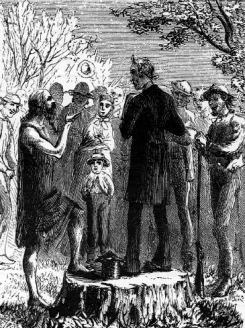
Chapman was also a friend to the Native Americans. This guy is so nice that I almost want to travel back in time and give him a big hug. I wouldn’t, however, because he sounds kind of grody. The Indians came to treat John with kindness, as he would give them medicinal plants. They also helped him in his travels. John blamed the majority of frontier violence on mistreatments of the Indians by the honkeys. Though he would blame his own people, John cared for every life. During a moment in the War of 1812, he elevated himself from legend to hero.
Many people believe that America won the Revolution and the British just said, “fuck all” and picked up and went home. This is of course not true. The British controlled Canada and many parts of the States. The British had been at war with France since 1793 and had begun to impede on trade between the Americas and their allies in France. That was the catalyst but The United States declared war on Britain on June 18, 1812 for a combination of reasons. The Indians allied themselves with the British in an effort to avenge themselves for atrocities that the settlers and government committed on them.
The Indians were ready to massacre the entire town of Mount Vernon. Johnny Appleseed got wind of this and raced “barefooted and bareheaded” through forests and rough terrain as if the whips of God were at his back. He ran for 30 miles from Mansfield to Mount Vernon, Ohio, to warn them of the impending attack and told them to obtain reinforcements. This act saved the lives of many settlers. Some said he rode a horse. I say that those naysayers are just not fucking American. Regardless of all this, he still was able to seamlessly move between the societies of the settlers and the natives.
Johnny Appleseed never took a bride. He was asked once and he replied, “I would not marry in this world, but have a pure wife in heaven.” However there are a few accounts that pointed to him liking them young. Young, like 8 or 10, so that she was a pure and beautiful virgin… which is pretty fucked up. There is another version where apparently Chapman made arrangements with an unknown frontier family in 1833 to raise their 10 year-old daughter to be his bride. He paid several visits to the girl, perhaps bringing her gifts of apples and contributed to her upkeep. But one day he saw that child bride to be was flirting with a boy her own age. They were most likely just making mud pies but he got furious and broke off the relationship. In this story, both Chapman and the family were f ‘d up beyond belief. They never mentioned this on the old Disney cartoon for some reason.
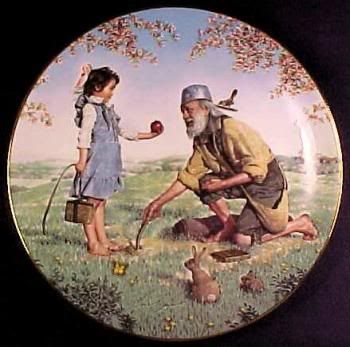
By the 1830s, his empire spanned from western Pennsylvania through central Ohio and into Indiana. In 1845, John went and visited a friend by the name of William Worth. They shared a meal of bread and milk. Johnny, of course, read aloud from the bible until the activities of the day wore him out and he stretched out on the floor to sleep. Johnny Appleseed never woke up. He died at the age of 70. This was a man who lived his life more sparsely than any preacher or priest and left behind an estate that included over 1,200 acres of prime real estate. With the land that was amassed he could have lived as a god but instead chose to serve one.
